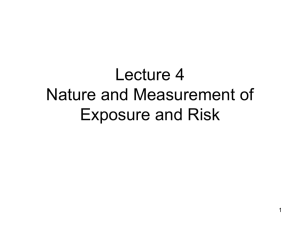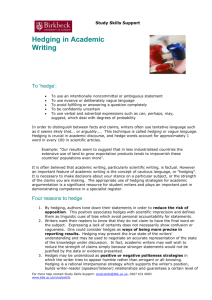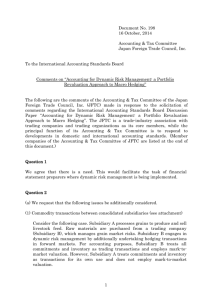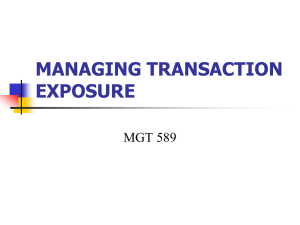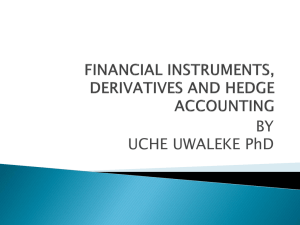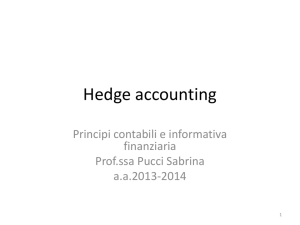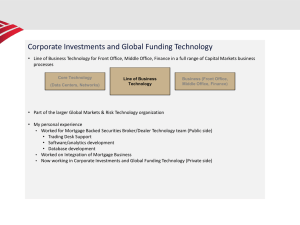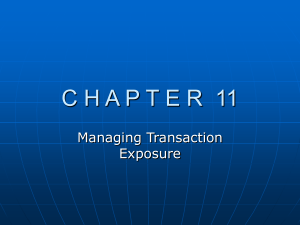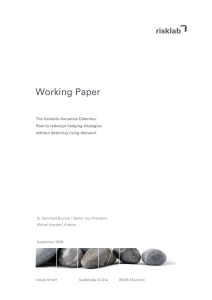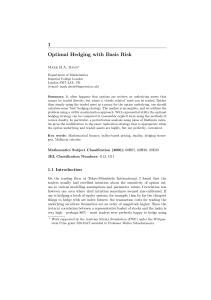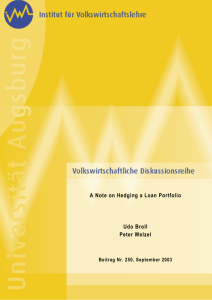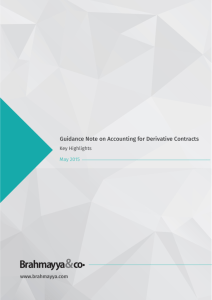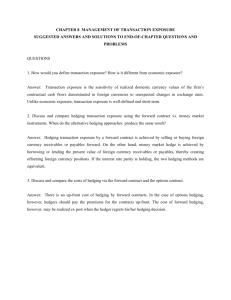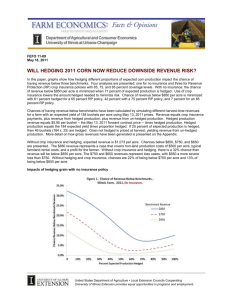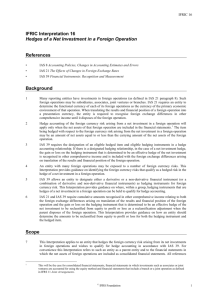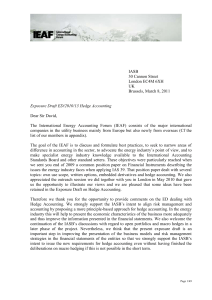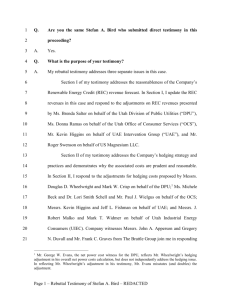Foreign Exchange Hedging Strategies at General
advertisement
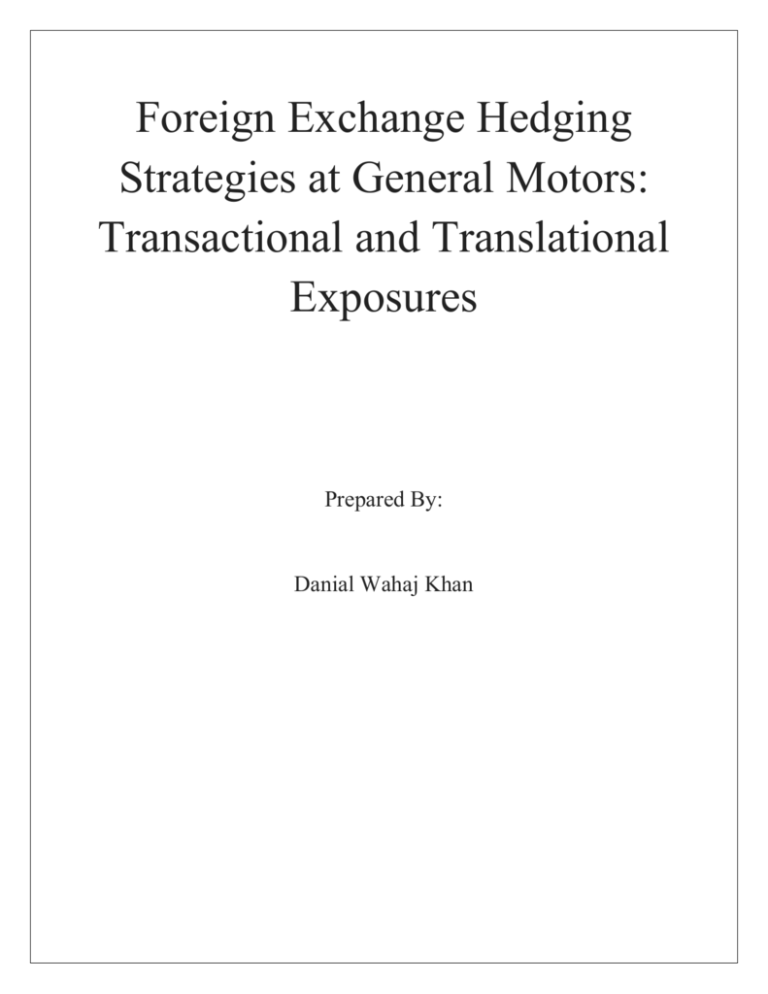
Foreign Exchange Hedging Strategies at General Motors: Transactional and Translational Exposures Prepared By: Danial Wahaj Khan EXECUTIVE SUMMARY: This report is based on a practical scenario solution of General motors. The report addresses the problem given in scenario which is the change in policy of hedging with detailed reasoning. The report then looks at the different available hedging instruments to the firm. Profitability of both instruments has been compared and lowest cost option was selected to mitigate the transactional risk. Translation risk has also been seen at different hedging ratio levels; current one and the proposed one. The options were more profitable to the firm that has been recommended. Argentinean subsidiary’s long term local currency problems have then be discussed with few different strategies that managers can adopt there. The appendix contains the technical calculations and graph that were necessary to support the decisions. INTRODUCTION: The case study addressed the exposure of General Motors to the foreign risk that arises due to its presence at a number of geographical locations and transactions in different foreign currencies. Corporate hedging policy does exist in this regard however there are two special cases that were addressed in the case study. The matters require special consideration as the existing policy is not very much appropriate to these two matters. One matter is the company’s exposure to the foreign exchange risk arises from Canadian subsidiary which has functional currency USD so CAD is foreign currency for this subsidiary. There are two types of risks that GM faces in this situation; one is translation risk and the other one is transaction risk. The company’ is looking at different hedging strategies to mitigate the risks and dealing with the matter exceptionally from the company’s policy. In order to that different instruments (options and forward contracts) should be analyzed for different level of hedge ratio plus favorable and unfavorable scenarios. Translation risks should also be discussed and impact of them on income statement should be estimated. The second matter is the management major translation risk arising in Argentina subsidiary due to recent major devaluation in the local currency. A strategy needs to be evaluated to deal with this long term risk. CANADIAN DOLLAR HEDGING: Forward rates contract is a popular and highly used hedging instruments. It has its advantages and disadvantages both. The main disadvantage is that it is a binding contract so company can’t take advantage of favorable movements. It is usually used where company is not interested in gains rather pure hedging. Options are option to buy or sell particular currency and they are usually expensive than other instruments as they give advantage of realizing upside exposure. Different hedging strategies for Canadian dollar risk are used. Particularly forward rates contract and options are used. The objective of our calculation is to reduce the total amount paid by GM in respect of 1.7 billion CAD cash to the suppliers. We first find out which is the most profitable hedging instrument on 50% hedge ratio then we estimate the total cost paid in using 75% and 50 % hedge ratio. Using the example data given in the case study we can estimate the total cost that should be paid by the company using 50% hedge ratio. The graph shows that the options are more profitable at 1.6 exchange rate.1.6 is the rate where both lines intersect each other. (App-1) Now we can analyze the income statement gain/ (loss) for the 2 scenarios for both 50% hedge ratio and 75% hedge ratio. The level of loss and gain both are more in 50% hedge ratio as compared to the 75% hedge ratio and similarly the EPS volatility is also more in 75% as compared to 50%. The difference is volatility is due to higher level of uncertainty involved in non hedged amount. (App-2) Translational risk is usually not hedged by the firms however if its impact is significant on the earnings of a company then hedging it is a safer option. Transaction risks should be hedged if there is high level of volatility in foreign exchange rates as it is in the case of Canadian subsidiary. Alternative strategies can also be used by netting off the amount or using futures however for that management’s time will be an issue. THE ARGENTINEAN PESO: The case with the Argentinean subsidiary is not similar to the first one. The Argentinean government is facing significant financial problems which throws doubts on its default. The country has very poor economic situation with no reforms and recent devaluation of currency has caused the managers to think over the strategy that should be followed. The manager did perform some hedging calculation though however hedging is used where there is risk in the short term and where risk cannot be transferred. In this case where we can easily see that local currency is devaluing with great pace we should look for a long term strategy. Hedging strategy of GM should not be altered in this regard however by other options we can find a solution. In such situations where government is facing hard times financially, government puts restriction on the level of remittance to the parent company. There is a significant risk involved with this investment and if there are any chances of this restriction then company should assess whether it is worthwhile to stay in operations there as it may cause severe problems for a company if it can’t withdraw its investments. Other options to deal with that could be borrowing in the local currency as it minimizes the level of payments that should be remitted to the parent. Another option could be the use of long term forex swap. This option is quite feasible for companies who have their investments stuck up in countries from where they can’t withdraw the investment in year or longer periods. RECOMMENDATION: The company faces significant level of currency risk due to geographical representation in a number of countries. The company has non centralized treasury function that has a number of tasks that are performed non-centrally. The company should make it centralized fully and try to net-off the amounts and should created best possible profitable results according to USD not local currencies. The company currently has hedge ratio of 50% and as we have seen the level of high volatility due to lower level of hedge ratio we suggest change in it. The hedge ratio should at least be 75% for commercial transactions to predict the results of earnings with more certainty. The translational risks can be minimized by borrowing in local currency so that overall risk can be netted off. The company should also evaluate the economical landscape of any country where it starts to work on because currencies are highly volatile to the changes in economical factors. The hedging instrument that should be used by company is options because it gave better results than forwards (can be seen in appendix). The options are better where there is more volatility or chances of going upside or downside are pretty much similar. APPENDIX: 1. Options Spot Rates 1.4 1.5 1.6 1.7 1.8 Strike Price 1.5667 1.5667 1.5667 1.5667 1.5667 Exercise Yes Yes No No No Future Spot Forward Rates Rate 1.4 1.5667 1.5 1.5667 1.6 1.5667 1.7 1.5667 1.8 1.5667 Premium Actual Payment 92551 14285714 92551 13333333 92551 12500000 92551 11764706 92551 11111111 Gain/(Loss ) Net Payment 76001 14302264 28382 13397502 -13284 12605835 -50049 11907306 -82729 11286391 Forwards Hedge Amount at Un-hedged Amount at Future Net Forward Rate Spot Rate Payment 6382843 7142857 13525700 6382843 6666667 13049510 6382843 6250000 12632843 6382843 5882353 12265196 6382843 5555556 11938398 Hedging Instruments Comparison 16000000 14000000 12000000 10000000 8000000 Options 6000000 Forwards 4000000 2000000 0 0 0.5 1 1.5 2 2. 50% Hedge Ratio Rates 1.627 1.529 Gain/(Loss) 44 -47 EPS Change 0.08 -0.09 Gain/(Loss) 36 -36 EPS Change 0.07 -0.07 75% Hedge Ratio Rates 1.627 1.529
